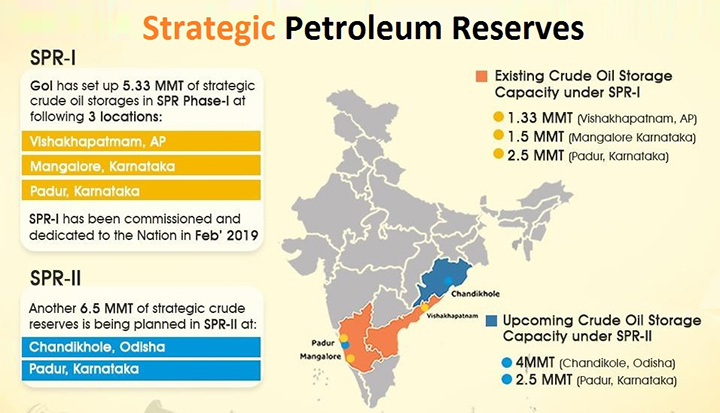Important Facts For Prelims
India's Strategic Petroleum Reserves
- 08 Aug 2023
- 4 min read
Why in News?
Recently, the Ministry of Petroleum & Natural Gas provided valuable insights into the Strategic Petroleum Reserve Programme during a written reply in the Lok Sabha.
What are Strategic Petroleum Reserves?
- About:
- Strategic petroleum reserves (SPRs) are stockpiles of crude oil maintained by countries ensuring a stable supply of crude oil even during times of geopolitical uncertainty or supply disruptions.
- These underground storage facilities play a crucial role in maintaining a steady flow of energy resources for the nation's growth and development.
Note:
- As per the terms of the International Energy Programme (I.E.P.) agreement, every nation belonging to the International Energy Agency (IEA) is required to maintain emergency reserves of oil amounting to a minimum of 90 days' worth of their net oil imports.
- In case of a severe oil supply disruption, IEA members may decide to release these stocks to the market as part of a collective action.
- In 2017, India attained the status of an associate member within the International Energy Agency.
- Current SPR Infrastructure and Capacity in India:
- Indian Strategic Petroleum Reserves Ltd. (ISPRL) was created by the Government of India as a Special Purpose Vehicle under the Ministry of Petroleum & Natural Gas in 2004.
- India's existing underground SPR facilities have a combined capacity of 5.33 Million Metric Tonnes (MMT) of crude oil. These storage sites are strategically positioned across two states:
- Visakhapatnam, Andhra Pradesh - 1.33 MMT capacity
- Mangaluru, Karnataka - 1.5 MMT capacity
- Padur, Karnataka - 2.5 MMT capacity
- Filling Strategy:
- Leveraging the opportunity presented by low crude oil prices in April/May 2020, India successfully filled its existing SPR facilities to full capacity.
- This tactical move resulted in substantial notional savings, estimated at around INR 5000 crore.
- Leveraging the opportunity presented by low crude oil prices in April/May 2020, India successfully filled its existing SPR facilities to full capacity.
- Expansion Plans and Commercial-Cum-Strategic Facilities
- In July 2021, the Indian Government granted approval for the establishment of two additional commercial-cum-strategic SPR facilities.
- Chandikhol, Odisha - 4 MMT capacity
- Padur, Karnataka - 2.5 MMT capacity (expansion)
- These facilities, totaling a storage capacity of 6.5 MMT, will operate under a Public Private Partnership (PPP) mode.
- In July 2021, the Indian Government granted approval for the establishment of two additional commercial-cum-strategic SPR facilities.
- Transfer and Timeline:
- At the conclusion of the 60-year Concession Period, the concessionaire will transfer the SPR, along with associated infrastructure such as Single Mooring Points (SPMs) and onshore/offshore pipelines, back to the Government of India.
- History of Reserve:
- In 1990, during the Gulf War in West Asia, India was grappling with a significant energy crisis, with its existing oil reserves deemed sufficient for only a mere three days.
- Although India successfully averted the crisis at that time, the persistent risk of energy disruptions remains a tangible and ongoing concern.
- In an effort to tackle this energy insecurity, the administration led by Atal Bihari Vajpayee put forward the idea of establishing strategic petroleum reserves in 1998.
- In the present day, as India's consumption of energy continues to rise, the rationale for developing such reserves becomes increasingly compelling.
- In 1990, during the Gulf War in West Asia, India was grappling with a significant energy crisis, with its existing oil reserves deemed sufficient for only a mere three days.
- Biggest Global Strategic Petroleum Reserves in the World:
- United States- 714 million barrels
- China- 475 million barrels
- Japan- 324 million barrels






-min.jpg)